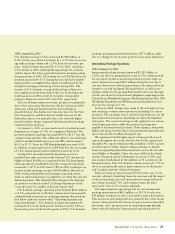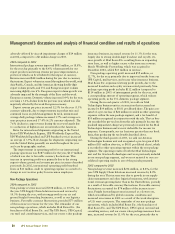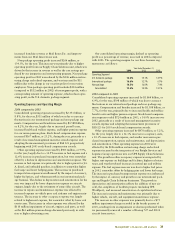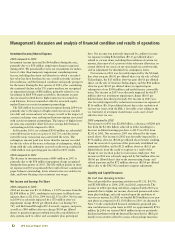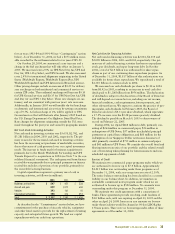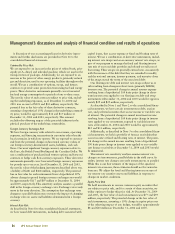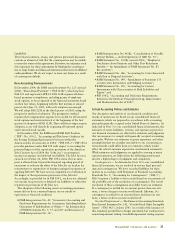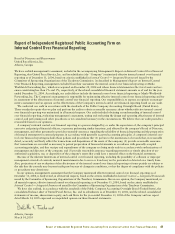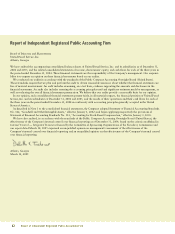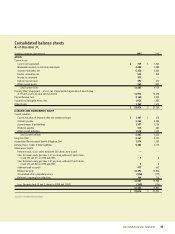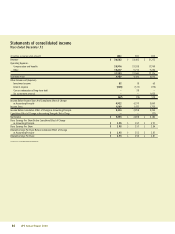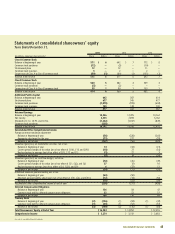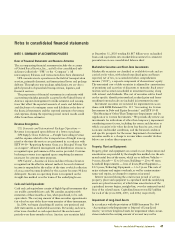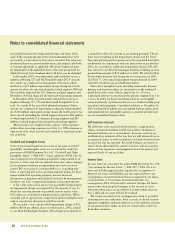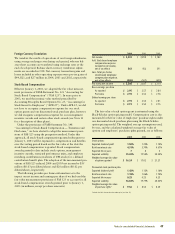UPS 2004 Annual Report Download - page 41
Download and view the complete annual report
Please find page 41 of the 2004 UPS annual report below. You can navigate through the pages in the report by either clicking on the pages listed below, or by using the keyword search tool below to find specific information within the annual report.
Management’s discussion and analysis 39
craft. As a result of the actual and planned retirement of these
aircraft, we conducted an impairment evaluation, which
resulted in a $110 million impairment charge during the fourth
quarter for these aircraft (including the related engines and
parts), $91 million of which impacted the U.S. domestic pack-
age segment and $19 million of which impacted the
international package segment.
These charges are classified in the caption “other expenses”
within other operating expenses (see Note 13 to the consolidated
financial statements). UPS continues to operate all of its other
aircraft and continues to experience positive cash flow.
Income Taxes — We operate in numerous countries around
the world and are subject to income taxes in many jurisdic-
tions. We estimate our annual effective income tax rate based
on statutory income tax rates in these jurisdictions and taking
into consideration items that are treated differently for finan-
cial reporting and tax purposes. The process of estimating our
effective income tax rate involves judgments related to tax
planning and expectations regarding future events. The
increasing profitability of our International segment increases
the significance of our non-U.S. income tax provision to our
overall effective income tax rate. We recognize deferred tax
assets for items that will generate tax deductions or credits in
future years. Realization of deferred tax assets requires suffi-
cient future taxable income (subject to any carry-forward
limitations) in the applicable jurisdictions. We make judgments
regarding the realizability of deferred tax assets based, in part,
on estimates of future taxable income. A valuation allowance
is established for the portion, if any, of the deferred tax assets
that we conclude cannot be realized. Income tax related con-
tingency matters also affect our effective income tax rate. In
this regard, we make judgments related to the identification
and quantification of income tax related contingency matters.
Forward-Looking Statements
“Management’s Discussion and Analysis of Financial Condition
and Results of Operations,” “Liquidity and Capital Resources”
and other parts of this report contain “forward-looking” state-
ments about matters that inherently are difficult to predict. The
words “believes,” “expects,” “anticipates,” “we see,” and similar
expressions are intended to identify forward-looking statements.
These statements include statements regarding our intent, belief
and current expectations about our strategic direction, prospects
and future results. We have described some of the important fac-
tors that affect these statements as we discussed each subject.
Forward-looking statements involve risks and uncertainties, and
certain factors may cause actual results to differ materially from
those contained in the forward-looking statements.
Risk Factors
The following are some of the factors that could cause our
actual results to differ materially from the expected results
described in our forward-looking statements:
nThe effect of general economic and other conditions in the
markets in which we operate, both in the United States and
internationally. Our operations in international markets
are also affected by currency exchange and inflation risks.
nThe impact of competition on a local, regional, national,
and international basis. Our competitors include the postal
services of the U.S. and other nations, various motor carriers,
express companies, freight forwarders, air couriers and oth-
ers. Our industry is undergoing rapid consolidation, and the
combining entities are competing aggressively for business.
nThe impact of complex and stringent aviation, transporta-
tion, environmental, labor, employment and other
governmental laws and regulations, and the impact of new
laws and regulations that may result from increased security
concerns following the events of September 11, 2001. Our
failure to comply with applicable laws, ordinances or regu-
lations could result in substantial fines or possible
revocation of our authority to conduct our operations.
nStrikes, work stoppages and slowdowns by our employees.
Such actions may affect our ability to meet our customers’
needs, and customers may do more business with competi-
tors if they believe that such actions may adversely affect
our ability to provide service. We may face permanent loss
of customers if we are unable to provide uninterrupted
service. The terms of future collective bargaining agree-
ments also may affect our competitive position and results
of operations.
nPossible disruption of supplies, or an increase in the prices,
of gasoline, diesel and jet fuel for our aircraft and delivery
vehicles as a result of war or other factors. We require sig-
nificant quantities of fuel and are exposed to the commodity
price risk associated with variations in the market price for
petroleum products.
nCyclical and seasonal fluctuations in our operating results
due to decreased demand for our services.


